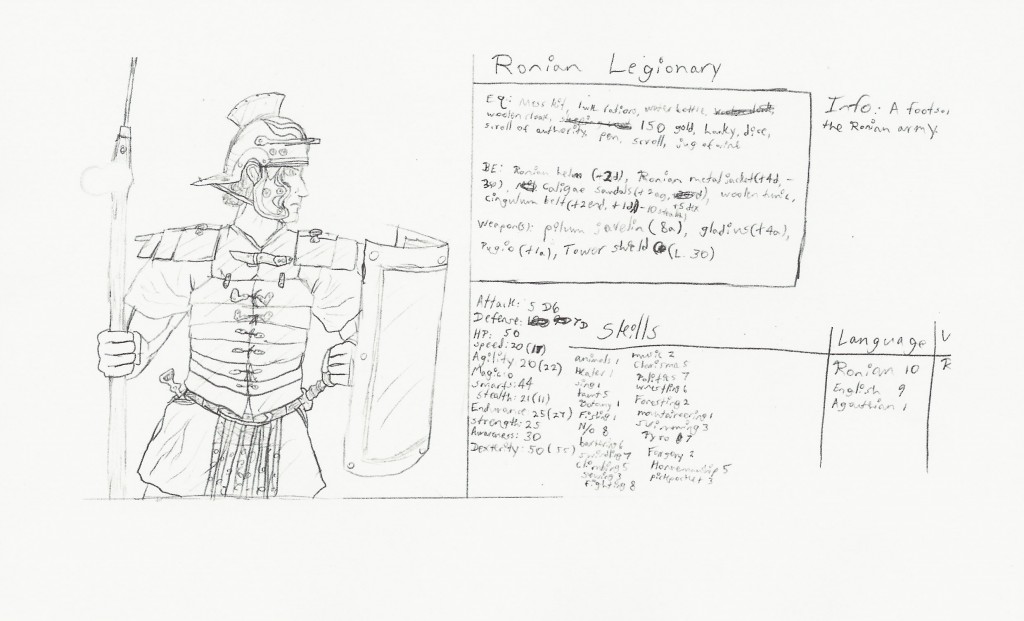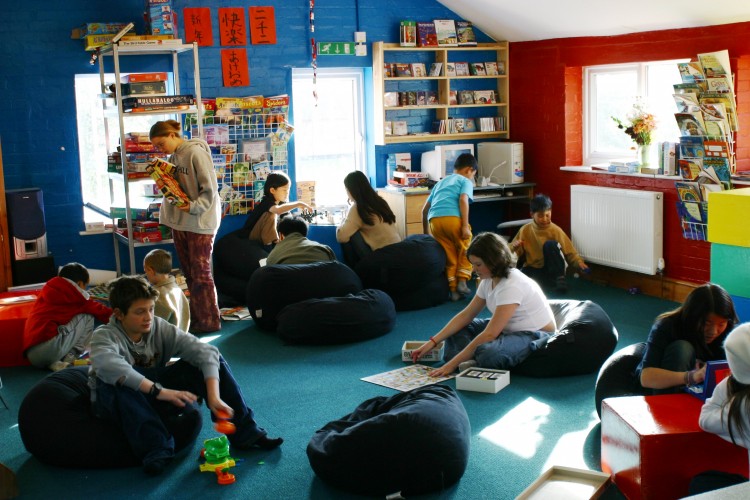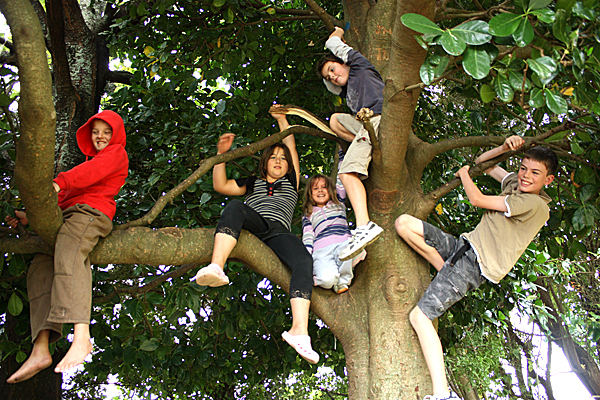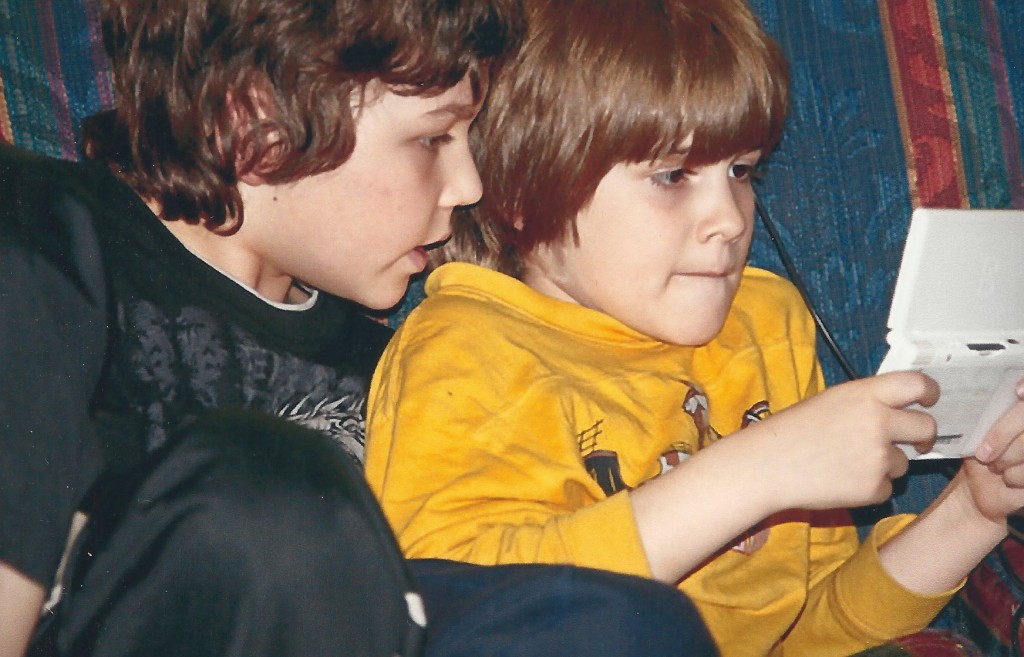 We’ve all heard the declarations on both sides of the coin, especially in the unschooling world. One side of the pendulum swing states, “Video games are fabulous; parents shouldn’t put any limits on access to them.” The other side of the pendulum swing states, “Too much video game playing is at the crux of many childhood issues, such as obesity, social isolation, and aggression.” In the category of video games (and other screen time), I think the reality of whether it’s a blessing or a curse falls in the middle of the pendulum swing: this technology is a great blessing if mindfully chosen and balanced in one’s life.
We’ve all heard the declarations on both sides of the coin, especially in the unschooling world. One side of the pendulum swing states, “Video games are fabulous; parents shouldn’t put any limits on access to them.” The other side of the pendulum swing states, “Too much video game playing is at the crux of many childhood issues, such as obesity, social isolation, and aggression.” In the category of video games (and other screen time), I think the reality of whether it’s a blessing or a curse falls in the middle of the pendulum swing: this technology is a great blessing if mindfully chosen and balanced in one’s life.
A Creative Outlet
For right-brained children, video games and computers are one of the possible creative outlets that are foundational to building their universal gifts of extraordinary imaginations and pictorial thinking. From my book, The Right Side of Normal, in the chapter about creative outlets, I write about the benefits of video games to a creative, right-brained child:
 Visual media have provided opportunities for visual, spatial and imaginative development in many of my right-brained children. It has been used as inspiration on the path to writing, a love of history, and computer programming. Many of us understand the benefits of eye-hand coordination, problem solving, and inference. Computers and video games aren’t just the newest technology that every young child accesses; they’re an important creative outlet for right-brained learners, just like the very people who created them!
Visual media have provided opportunities for visual, spatial and imaginative development in many of my right-brained children. It has been used as inspiration on the path to writing, a love of history, and computer programming. Many of us understand the benefits of eye-hand coordination, problem solving, and inference. Computers and video games aren’t just the newest technology that every young child accesses; they’re an important creative outlet for right-brained learners, just like the very people who created them!
Inspiration for Writing. Computer and video games have inspired my artist son resulting in a variety of visual-based products. The development of writing is a left-brained favored task often cultivated in right-brained children between 11 and 13 years. Video games inspired my artist son to undertake his writing (see Chapter Thirteen). After discovering someone wrote a novel based on his favorite video game at the time, The Legend of Zelda®, he was sorely disappointed in its lack of detail. He decided he could do better, so at age 11 he sat at the computer and began a well-written descriptive narrative of the game he loved. He’d never written in a traditional way before this, yet the writing was outstanding. He made it to about 35 single-spaced typewritten pages before losing interest. However, in his late teens, he again decided to write a novel based on a video game, Final Fantasy VII®, and this time he made it to 300+ pages. What these novels had in common was the visual detail he wanted to bring to the story writing process.
Inspiration for History. My artist son’s natural love of history grew as he discovered how often video games honored historical accuracy. Therefore, any writings or drawings of even mythical depictions were meticulously historically researched to bring added credibility to his creations. I remember when all the card crazes ignited. My artist son created his own card games using visual images from computer and video games as inspiration while adding carefully researched details.
Inspiration for Computer Programming. Compare the visual inspiration gained by my artist son to the focus of my builder son toward puzzling out the spatial nature behind the creation of computer and video games. My builder son clocked as many hours playing these types of games over the years as his artist brother. But he would initially build LEGO® models of interesting objects depicted in these games, which then progressed to an  interest in computer programming beginning around age 13. Instead of looking at the visuals in the games, he contemplated the creation behind the games as he played.
interest in computer programming beginning around age 13. Instead of looking at the visuals in the games, he contemplated the creation behind the games as he played.
Inspiration for Imagination. My theater son enjoys the inspired fodder found through video games, computers, and other visual media such as movies and television. He usually doesn’t get through an entire show before he heads to his dress-up bin. Sometimes he also looks for other resources around the house, with or without permission, to recreate through costuming what he experienced. My theater son needs the whole body experience of any visual media he integrates.
When we value visual media, there are diverse positive outcomes, particularly as a creative outlet for a right-brained learner. Pictorial images can be collected for use when translating images into symbolic representations. Inspiration can be garnered for visual detail for other subject areas. Visual media can provide fodder for career options, or it can allow opportunities to try on diverse roles.
Balance
As noted, I highly value the benefits of video games and other screen media. At the same time, I witnessed over the years, whether with my children or myself or those I observed, that striving for balance is important. If you help your child stay tapped into their emotional intelligence, they are well aware of feeling out of balance for themselves. Here is a fascinating opportunity where children in the longest known democratic school came to their own conclusions that video games and other screens needed to be balanced: From Leonard of Summerhill School in the UK:
Democratic Schools are on the cutting edge of the investigation of the internet/hi-tech/video games cultural upheaval. I came to Summerhill School 12 years ago. We still had VHS tapes; a few staff had mobiles. We had a small computer room that was internet connected via cable. Film nights were a big deal, a community event. Board games prevailed. Warhammer, Dungeons and Dragons.
There have been many hi-tech ‘generations’ of children in those 12 years. The speed of change is breathtaking. Early on the little kids came to the meeting and asked us to pass a law saying they couldn’t use hand-held DS games in the daytime because ‘we can’t stop ourselves from using them’ … they remembered a time without them. Young kids now are practically born with I-pads and DS games and X-boxes and films on demand, mobile phones and wifi … and so the school has had to deal with this and what it means to individuals, to community, to free choice learning and lessons.
The Summerhill meeting (people 7 years to 66 ) has discussed and wrestled with many issues regarding this cultural change, trying certain laws, changing them, dropping them, making new ones and so on as we worked together on the problems and advantages of modern culture. (Kind of a good thing for young people to be deeply engaged in I should think.) For a brief period we tried no restrictions on when people could use ‘screens’. It was quickly seen as a serious mistake … the children soon decided that many of them found it a real struggle to break away from screens even if they wanted to, that many parents would ultimately not send their children to a school where students could only be found glued to computers all day, that the government would be on us like a pack of wolves; in general, they concluded that it was badly messing up the sense of community and free play and doing that the community cherished. So laws were passed about two years ago that restricts the use of screening except in classrooms during what we call ‘the school day’ (this is a boarding school) which is from 9 am till 3 pm weekdays. Breaking the law generally brings a voted upon 24 hour screen ban.
So child self regulation/child awareness has reached the conclusion that some control is a good thing. (As one person said, trees don’t sit around coming up with ways to make money from making children have a need to climb them) although most students deeply value hi-tech and gaming and take part in it a great deal.
With our laws, the children play, run about, climb trees, ride bikes, engage in projects and also freely chosen formal learning, make wooden swords and bows and arrows and run off into the woods. Before the laws we made for ourselves much of these activities began to fade away from the school’s daily life. It was that dramatic.
But what an invaluable learning experience we continue to go through as the culture tosses up it’s positives and negatives at our democratic school/community.
This is similar to how our collaboration worked in our family about screen time. In their early childhood years (5 to 10 years old), we agreed on what worked for balance for each child and the family as a whole in order to make space for all their interests and gifts to develop. I asked my artist son recently about the time when it was video game Fridays where the three oldest had to work out their own system to play on one television for that one day. He said it was the right balance for him at the time. Here’s an except from my book, The Right Side of Normal, about screens and balance:
Visual Media Balance. Admittedly, visual media has a captivating quality. I believe in balance for each child within my care. However, balance is different for every person. Further, value gained from the resource needs to be factored in. Video games, the computer, and television are valid creative outlets for a right-brained person. That said, one child may be involved with them for three to four hours a day at a particular age, while another the same age can spend six to seven hours and be in balance. I helped each child understand his unique limits and needs as he matured. This way, by the time they became teens, each was capable of self-governance and balance continued.
I remember a time when my oldest artist son, the one most prone to over-indulgence with video game playing, went through a time he needed to develop his self-regulation better. I share here in my book how we collaborated through this:
[M]y oldest right-brained artist son … loved playing video games starting at 5 years old. At around 8 to 9 years old, he went through a stage that appeared to be obsessive. In actuality, it had shifted into that realm … because he didn’t have self-regulation skills. Video games weren’t fun anymore, and he acted out in frustration, refusing to stop playing because he had to make it to the next level. His actions became spastic and his attitude ugly. … I could give my 9-year-old good information about what he was experiencing, how to manage it effectively, and explain what had happened to something that was of high interest to him. After a year’s time of discussion, collaboration, and knowledge sharing, he was able to self-regulate and maintain balance to place his video game interest back into passion mode without needing a break from it.
Positive Skill Sets
All of this said about those who enjoy video games and other screens and its benefits, as well as a discussion about balance, I also have children who didn’t have a natural skill with playing video games, though they had an interest in it. The first example is my youngest son with autism. When he was between 8 and 10 years old, he enjoyed watching his older siblings play as they added commentary. He greatly enjoyed the effects of visual input and verbal description. Finally, his siblings grew tired of entertaining him after he began to ask on a consistent basis, so we decided we would empower him to learn for himself.
First, he learned to provide his own commentary as his siblings played a video game through helpful and encouraging modeling. After his competency grew in this area, he learned to play the video games while his sibling supplied commentary. Finally, he was able to put the two together. This took a space of about one year. My son with autism not only learned a skill for himself that he enjoyed, but his confidence grew.
My younger two active, outdoors, kinesthetic, sports-oriented boys (whom we adopted) displayed skills in physical skills that my cerebral, visual, book- and project-focused birth sons didn’t. And vice versa. It was particularly evident in my active sons’ inability to access the skills that are obviously necessary to be successful video game players. Whereas before, since it was so natural for my birth children, I had thought these skills were self-evident in today’s children, my younger children helped me understand that there is a specific skill set. At 12 and 14 years old, they are just now developing their abilities in video games. In fact, I actually encouraged their play. It was touch and go in their desire because of the roadblocks they continually faced to become proficient, but with some specific tutoring from older siblings, and some well chosen games, they are getting a foothold.
The Why is Important
 Why you do what you do is highly important. It can look exactly the same on the outside, but the why changes how everything is impacting your insides. For instance, we can see various young people engaging in video games for half their day, but depending on the reason why will determine if we should be concerned or not:
Why you do what you do is highly important. It can look exactly the same on the outside, but the why changes how everything is impacting your insides. For instance, we can see various young people engaging in video games for half their day, but depending on the reason why will determine if we should be concerned or not:
- One has a passion for video game programming, and he got his newest game today and is enthusiastically exploring its features. It falls in the family of video game genres known to stimulate thinking skills (RPG, simulation, and quest/adventure).
- Another is feeling bored. She turns to video games for easy entertainment. She’s a natural and it lifts her spirits. Why exert energy elsewhere when the next level is so enticing?
- Another has bipolar and has been stabilized with medication, but life can still be difficult. He uses video games to be engaged in something to quiet his mind and/or distract himself in between the times he carefully reengages in life.
- Another has been feeling depressed for a while and doesn’t feel like he needs to seek out help. He turns to video games to make himself feel better. His agitation increases over his situation and he begins to choose more and more aggressive games to feel empowered.
- Another is a creative person who seeks out a little down time like every other person. She enjoys the visual and creative aspect. It’s her choice of entertainment.
Being informed, involved, and observant allows the screen technologies to be a blessing instead of a curse in you and your children’s lives. Being informed means you know what are better choices for children at various ages as it pertains to style and rating level, and you’ve become versed in both the benefits and the negative signs so as to capitalize on the one and minimize the other. Being involved means you watch your child play video games from time to time, maybe even joining in, and know what’s going on in your child’s life overall so as to understand that child’s whys for playing. Being observant means you notice shifts in mood, behavior, and interests and look to discover the meaning behind each.
I’m excited to see many more balanced articles out now about the benefits of video game playing, while not turning a blind eye to warnings for potential ill effects. Being educated about the positive use of video games, while being mindful of the negative signs, will create far more blessing than curse.
What kind of whys, benefits, or stumbling blocks have you encountered around video game playing? How do you feel about it?
If you benefited from this content, please consider supporting me by buying access to all of my premium content for a one-time fee of $15 found here. This will even include a 50% off e-mail link toward a copy of my popular The Right Side of Normal e-book (regularly $11.95)!










Pingback: Your Child Might Be Right-Brained If … | The Right Side of Normal
Pingback: A Different Process and Product |